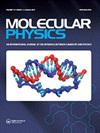分子极化的统计力学实用指南
IF 1.6
4区 化学
Q4 CHEMISTRY, PHYSICAL
引用次数: 1
摘要
摘要提出了一种针对分子系综与无损腔模式耦合的量子统计力学的理论方法。考虑了典型系综,并设计了由腔-分子耦合引起的亥姆霍兹自由能修正的近似公式,从而可以推导出实验可测量的热力学量。假设空腔模式的频率在红外范围内。因此,腔与分子振动耦合,我们的处理仅限于分子的电子基态。对一维谐振子耦合到腔体的解析可解模型系统进行了验证。详细讨论了该近似的性能及其有效范围。结果表明,亥姆霍兹自由能的前阶修正量与集体耦合强度的平方成正比。我们还证明了在集体超强耦合状态下,腔模式对系统的热力学性质没有显著影响(集体耦合强度与腔模式的频率相当)。关键词:极化化学;分子极化;统计力学;本文章由计算机程序翻译,如有差异,请以英文原文为准。
Practical guide to the statistical mechanics of molecular polaritons
AbstractA theoretical approach aimed at the quantum statistical mechanics of a molecular ensemble coupled to a lossless cavity mode is presented. A canonical ensemble is considered and an approximate formula is devised for the Helmholtz free energy correction due to cavity-molecule coupling, which enables the derivation of experimentally measurable thermodynamic quantities. The frequency of the cavity mode is assumed to lie in the infrared range. Therefore, the cavity couples to molecular vibrations and our treatment is restricted to the electronic ground state of the molecule. The method is tested for an analytically solvable model system of one-dimensional harmonic oscillators coupled to the cavity. The performance of the approximation and its range of validity are discussed in detail. It is shown that the leading-order correction to the Helmholtz free energy is proportional to the square of the collective coupling strength. We also demonstrate that the cavity mode does not have a significant impact on the thermodynamic properties of the system in the collective ultrastrong coupling regime (the collective coupling strength is comparable to the frequency of the cavity mode).Keywords: Polaritonic chemistrymolecular polaritonsstatistical mechanicscanonical ensemble Disclosure statementNo potential conflict of interest was reported by the author(s).
求助全文
通过发布文献求助,成功后即可免费获取论文全文。
去求助
来源期刊

Molecular Physics
物理-物理:原子、分子和化学物理
CiteScore
3.60
自引率
5.90%
发文量
269
审稿时长
2 months
期刊介绍:
Molecular Physics is a well-established international journal publishing original high quality papers in chemical physics and physical chemistry. The journal covers all experimental and theoretical aspects of molecular science, from electronic structure, molecular dynamics, spectroscopy and reaction kinetics to condensed matter, surface science, and statistical mechanics of simple and complex fluids. Contributions include full papers, preliminary communications, research notes and invited topical review articles.
 求助内容:
求助内容: 应助结果提醒方式:
应助结果提醒方式:


